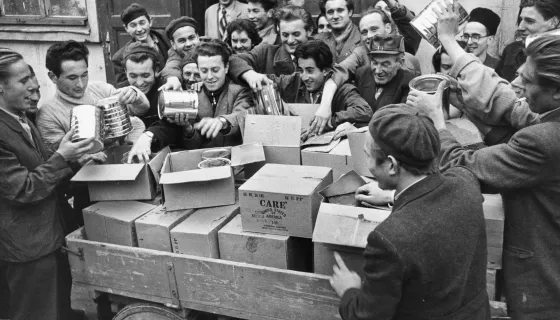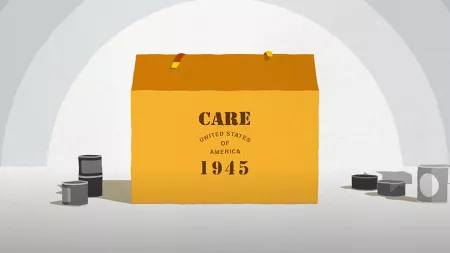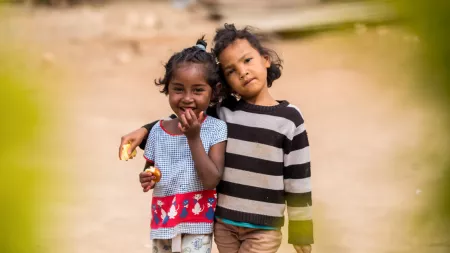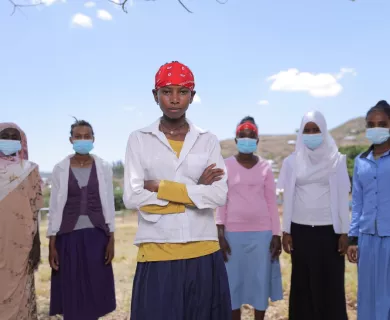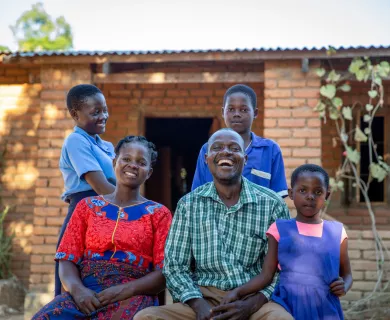CARE's history
CARE International is one of the world’s largest organizations dedicated to saving lives and fighting poverty. We help provide relief to people hit by emergencies, and contribute to economic empowerment that strengthens livelihoods over the long term.
What is now a global network of partners working around the world started with a simple emergency relief package, delivered over eight decades ago.
CARE in a box
Known then as the Cooperative for American Remittances to Europe, CARE consisted of 22 American charities of civic, religious, cooperative, and labour backgrounds.
The first CARE Package™ arrived in Le Havre, France, in May 1946. It was the first in a wave of responses to millions of people in need of food and relief supplies at the end of World War II.
In 1948, as Soviet troops blockaded Berlin, CARE chartered its own planes to participate in the historic Berlin airlift, providing about 60% of all private aid to the beleaguered city.
From remittances in Europe to relief everywhere
With Europe on the road to recovery, CARE found itself increasingly involved in Asia – first in Japan and then in the Philippines, Korea, India, and Pakistan.
By the early 1950s, operations had been established in a number of Latin American countries, followed by Africa in the early 1960s. CARE at this time also began providing medical services as well as assistance to people in war-torn areas.
In many places around the world where humanitarian relief was needed, CARE and our partners were present. In recognition of increasingly global work, CARE changed its name in 1953 to the Cooperative for American Relief Everywhere.
Throughout the 1960s and 1970s, CARE expanded its remit beyond immediate and short-term relief to long-term, people-centred development assistance. Following the establishment of the Peace Corps by US President John F. Kennedy in 1961, CARE began to train volunteers and help manage the Peace Corps’ first projects.
We continued to help provide food in the aftermath of humanitarian crises, but also started innovative projects to help communities better provide for themselves.
From CARE to CARE International
CARE opened an office in Canada in 1946. However, it was not until the mid-1970s that the organization truly started to become an international body.
CARE Canada (initially Care of Canada) became an autonomous body in 1973. In 1976, CARE Europe was established in Bonn following the successful fundraising campaign "Dank an CARE" (Thanks to CARE). In 1981, CARE Germany was created, and CARE Europe moved its headquarters to Paris.
CARE Norway followed in 1980, and later that year CARE offices in Italy and the UK were also established. The popularity of CARE offices in Europe was attributed to the fact that many Europeans remembered receiving CARE assistance after World War II.
In 1979, planning began to establish an umbrella organization to coordinate and prevent duplication among the various national CARE organizations. This new body was named CARE International. It met for the first time on January 29, 1982, bringing together representatives from CARE Canada, CARE Germany, CARE Norway, and CARE USA.
CARE International would expand significantly during the 1980s, with the addition of CARE France in 1983; CARE International UK in 1985; CARE Austria in 1986; and CARE Australia, CARE Denmark, and CARE Japan in 1987.
Beginning the focus on women and girls
In the early 1980s, CARE’s longer-term development programs increasingly began focusing on ways to improve the status of women and girls and encourage their greater participation. We were seeing that empowered women and girls improve not only their own lives, but also that of the communities around them.
When women earn, everyone benefits. This was CARE’s guiding vision when we launched our first Village Savings and Loan Associations (VSLAs) in Niger in 1991, still today one of our flagship programs for women's economic empowerment.
VSLAs are inspired by the ancient African practice of group savings, in which community members pool their resources to create a kind of village bank. The method provides an effective strategy for women to save small amounts, see their collective savings grow, and borrow money in times of hardship, such as droughts or illness, or to invest in setting up a small business.
From the civil war in Rwanda to the Gulf War, CARE International and our partners were there providing relief to millions of people in need.
In 1993, to reflect the wider scope of our programs and impact, CARE changed the meaning of its acronym to Cooperative for Assistance and Relief Everywhere.
